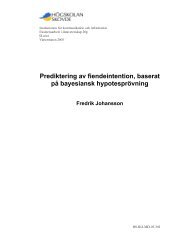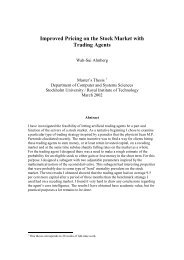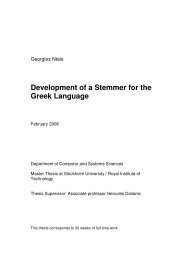Modeling Hydra Behavior Using Methods Founded in Behavior-Based Robotics
Modeling Hydra Behavior Using Methods Founded in ... - SAIS
Modeling Hydra Behavior Using Methods Founded in ... - SAIS
You also want an ePaper? Increase the reach of your titles
YUMPU automatically turns print PDFs into web optimized ePapers that Google loves.
38 Chapter 7. Results and discussionTransfer functionThe TF of B3 share the same task as the one of B2, namely to evoke a CP or an LP,whichever is applicable. Eqs. 7.9 and 7.10 were applied to determ<strong>in</strong>e response type also<strong>in</strong> this case. Similar to B2, the time for the applicable response was set to t + L l , wheret is the time for activation of the AC, and L l is the latency as determ<strong>in</strong>ed above. Also <strong>in</strong>this case, the duration of a CP was set to 10 s, and the duration of an LP to 60 s.7.1.4 B4: Feed<strong>in</strong>gThe feed<strong>in</strong>g behavior of <strong>Hydra</strong> is activated by the presence of GSH and, as discussed<strong>in</strong> Section 5.1.3, both activation threshold and duration of the response depend on thenutritional state of the animal. Throughout the feed<strong>in</strong>g response, there is a total <strong>in</strong>hibitionof other behaviors [52].Applicability clauseAlso for B4, an event-driven AC was used. The activation threshold and duration ofresponse were determ<strong>in</strong>ed with respect to measured data from experimental studies of theanimal.The threshold for activation of the feed<strong>in</strong>g behavior <strong>in</strong> <strong>Hydra</strong> depends on time ofstarvation. In [31], a quantitative study of this relationship was conducted. The results<strong>in</strong>dicates an exponential decrease <strong>in</strong> the feed<strong>in</strong>g threshold, T f , for an <strong>in</strong>crease <strong>in</strong> starvationtime. In a least square function fitt<strong>in</strong>g to the measured data, Eq. 7.12 was obta<strong>in</strong>ed. Theresults are shown <strong>in</strong> Fig. 7.8.T f =1.29 · 104, (7.12)Mh1.95where M h is <strong>in</strong>creased by 1 per second while the animal is not feed<strong>in</strong>g, see Eq. 6.5.The duration of B4 have been studied <strong>in</strong> [33], and <strong>in</strong>dicates a gradual recovery ofthe ability to respond follow<strong>in</strong>g a prior feed<strong>in</strong>g response. The follow<strong>in</strong>g relation wasdeterm<strong>in</strong>ed for the ability of feed<strong>in</strong>g durationD f = 1800 ( 1 − e −0.2x) , (7.13)where x = M h3600. Fig. 7.9 shows the gradual recovery.Activation of the AC occurs if M c > T f , while the AC is reset if t B4 > D f , or if M c = 0,where t B4 is the time for which B4 has been active and D f is the ability of duration of thefeed<strong>in</strong>g response at the time of activation of B4. Thus, feed<strong>in</strong>g occurs until repletion oruntil the presence of food is no longer detected by the sensory system.





